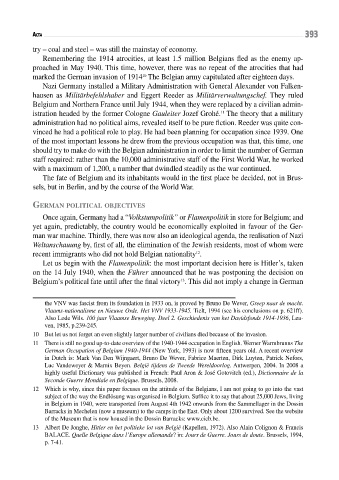Page 393 - Conflitti Militari e Popolazioni Civili - Tomo I
P. 393
393
aCta
try – coal and steel – was still the mainstay of economy.
Remembering the 1914 atrocities, at least 1.5 million Belgians fled as the enemy ap-
proached in May 1940. This time, however, there was no repeat of the atrocities that had
marked the German invasion of 1914 The Belgian army capitulated after eighteen days.
10
Nazi Germany installed a Military Administration with General Alexander von Falken-
hausen as Militärbefehlshaber and eggert Reeder as Militärverwaltungschef. They ruled
Belgium and Northern France until July 1944, when they were replaced by a civilian admin-
istration headed by the former Cologne Gauleiter Jozef Grohé. The theory that a military
11
administration had no political aims, revealed itself to be pure fiction. Reeder was quite con-
vinced he had a political role to play. He had been planning for occupation since 1939. One
of the most important lessons he drew from the previous occupation was that, this time, one
should try to make do with the Belgian administration in order to limit the number of German
staff required: rather than the 10,000 administrative staff of the First World War, he worked
with a maximum of 1,200, a number that dwindled steadily as the war continued.
The fate of Belgium and its inhabitants would in the first place be decided, not in Brus-
sels, but in Berlin, and by the course of the World War.
gerMan POlitical ObjectiVes
Once again, Germany had a “Volkstumpolitik” or Flamenpolitik in store for Belgium; and
yet again, predictably, the country would be economically exploited in favour of the Ger-
man war machine. Thirdly, there was now also an ideological agenda, the realisation of Nazi
Weltanschauung by, first of all, the elimination of the Jewish residents, most of whom were
recent immigrants who did not hold Belgian nationality .
12
let us begin with the Flamenpolitik: the most important decision here is Hitler’s, taken
on the 14 July 1940, when the Führer announced that he was postponing the decision on
Belgium’s political fate until after the final victory . This did not imply a change in German
13
the VNV was fascist from its foundation in 1933 on, is proved by Bruno De Wever, Greep naar de macht.
Vlaams-nationalisme en Nieuwe Orde. Het VNV 1933-1945. Tielt, 1994 (see his conclusions on p. 621ff).
also lode Wils. 100 jaar Vlaamse Beweging. Deel 2. Geschiedenis van het Davidsfonds 1914-1936, leu-
ven, 1985, p.239-245.
10 But let us not forget an even slightly larger number of civilians died because of the invasion.
11 There is still no good up-to-date overview of the 1940-1944 occupation in English. Werner Warmbrunns The
German Occupation of Belgium 1940-1944 (New York, 1993) is now fifteen years old. A recent overview
in Dutch is: Mark Van Den Wijngaert, Bruno De Wever, Fabrice Maerten, Dirk Luyten, Patrick Nefors,
luc Vandeweyer & Marnix Beyen. België tijdens de Tweede Wereldoorlog. Antwerpen, 2004. In 2008 a
highly useful Dictionary was published in French: Paul Aron & José Gotovitch (ed.), Dictionnaire de la
Seconde Guerre Mondiale en Belgique. Brussels, 2008.
12 Which is why, since this paper focuses on the attitude of the Belgians, I am not going to go into the vast
subject of the way the Endlösung was organised in Belgium. Suffice it to say that about 25,000 Jews, living
in Belgium in 1940, were transported from August 4th 1942 onwards from the Sammellager in the Dossin
Barracks in Mechelen (now a museum) to the camps in the East. Only about 1200 survived. See the website
of the Museum that is now housed in the Dossin Barracks: www.cicb.be.
13 Albert De Jonghe, Hitler en het politieke lot van België (Kapellen, 1972). Also Alain Colignon & Francis
BalaCe. Quelle Belgique dans l’Europe allemande? in: Jours de Guerre. Jours de doute. Brussels, 1994,
p. 7-41.

